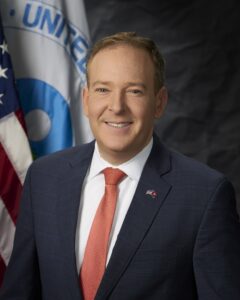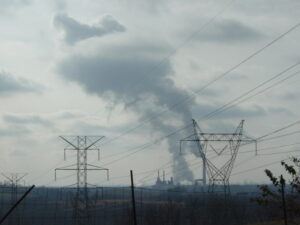Environmental justice efforts at the 10 U.S. Environmental Protection Agency regional offices have stopped and employees have been placed on administrative leave, per an announcement from EPA Administrator Lee Zeldin last month. Former EPA employees involved with environmental justice work across the country say rural communities will suffer as a result.

Before being shuttered in early March, the EPA’s environmental justice arm was aimed at making sure communities were being treated fairly and receiving their due protection under the Clean Air Act and Clean Water Act. Zealan Hoover, former senior advisor to the EPA administrator under the Biden administration, told the Daily Yonder that this work had big implications for rural places since there are pollution concerns in rural areas across the country.
“EPA was very focused on making sure that not just on the regulatory side, but also on the investment side, we were pushing resources into rural communities,” said Hoover.
According to Hoover, most of the pollution challenges the U.S. faces are not new. He said that the employees — now on leave — who staffed the EPA’s regional environmental justice offices were deeply knowledgeable on the issues affecting communities in their regions; issues which can go on for decades. Hoover said he worries about recent changes to the agency under the Trump administration, which also include a series of deregulatory actions and a proposed 65% budget cut.
“I trust that the great folks at EPA who remain will still try valiantly to fill those gaps, but the reality is that this administration is pushing to cut EPA’s budget, pushing employees to leave, and that’s going to restrict EPA’s ability to help rural communities tackle their most significant pollution challenges,” Hoover said.
One rural community that has faced years of environmental challenges is where Sherri White-Williamson lives in rural Sampson County, North Carolina. In 2021, the county’s landfill ranked second on the list of highest methane emitters in the U.S. The county is also the second-largest producer of hogs nationwide, and in 2022, it accounted for nearly 3% of all U.S. hog sales.

The hog industry is known for its pollution from open waste storage pits that emit toxic chemicals into nearby neighborhoods. For years, concerns about North Carolina’s hog industry have centered on the disproportionate harm that its pollution does to low-income communities and communities of color since hog farms frequently locate their operations adjacent to such communities in rural counties.
White-Williamson is also an EPA veteran. She worked on environmental justice initiatives at the agency’s Washington, D.C. office for over a decade before moving back home to southeastern North Carolina. She is now the executive director of the Environmental Justice Community Action Network, or EJCAN, which she founded in Sampson County in 2020 to empower her neighbors amidst environmental challenges like those wrought by the hog farms and the landfill.
In her early work with EJCAN, White-Williamson said she noticed that conversations about environmental justice often centered on urban areas. Since then, White-Williamson said she has focused on educating the public about what environmental justice looks like in rural communities.
“A lot of our issues have to do with what the cities don’t want or dispose of will end up in our communities,” said White-Williamson. “The pollution, the pesticides, the remnants of the food processing all ends up or stays here while all of the nice, clean, freshly prepared product ends up in a local urban grocery store somewhere.”
Another misconception about environmental justice, according to White-Williamson, is that it exists exclusively to serve communities of color. During her time at the EPA, White-Williamson said she spent time in communities with all kinds of racial demographics while working on environmental justice initiatives.

“I spent a lot of time in places like West Virginia and Kentucky, and places where the populations aren’t necessarily of color, but they are poor-income or low-income places where folks do not have access to the levers of power,” White-Williamson said.
When pollution impacts local health in communities without access to such “levers of power,” the EPA’s regional environmental justice offices were a resource — and a form of accountability. Without those offices, it will be more difficult for rural communities to get the services they need to address health concerns, said Dr. Margot Brown, senior vice president of justice and equity at the Environmental Defense Fund.
“They’re dismantling the ecosystem of health protections for rural Americans, and by dismantling them, they’ll make them more susceptible to future hazards,” Brown said of the Trump administration’s decisions at the EPA. “It will impair health and well-being for generations to come.”
Brown worked at the EPA for nearly 10 years under President Barack Obama and then under President Donald Trump during his first administration. Her time there included a stint as Deputy Director of the Office of Children’s Health Protection. She, along with Hoover and White-Williamson, said that community members will likely need to turn to their state governments or departments of environmental quality in the absence of the regional environmental justice offices.
But White-Williamson noted that state governments, too, receive federal funding. Frozen funds across federal agencies and cuts to healthcare programs, including Medicaid, could wind up compounding challenges for rural communities trying to mitigate environmental health impacts.
“The communities that most need the assistance and guidance will again find themselves on the short end of the stick and end up being the ones that are suffering more than anybody else,” White-Williamson said.
Hoover described it as a “one-two punch” for rural communities. On the one hand, he said, rural places are losing access to healthcare facilities because of budget cuts.
“And on the other hand, they are also sicker because the government is no longer stopping polluters from polluting their air and their water.”
This article first appeared on The Daily Yonder and is republished here under a Creative Commons license. Banner image: A sign at the U.S. Environmental Protection Agency headquarters in Washington, D.C. (G. Edward Johnson, CC BY 4.0, via Wikimedia Commons).
Sign up for The Invading Sea newsletter by visiting here. To support The Invading Sea, click here to make a donation. If you are interested in submitting an opinion piece to The Invading Sea, email Editor Nathan Crabbe at ncrabbe@fau.edu.



